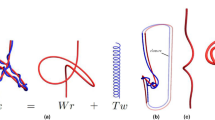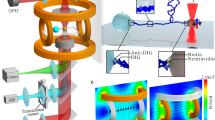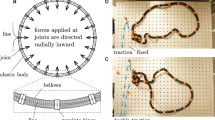Abstract
The mechanics of DNA bending on intermediate length scales (5–100 nm) plays a key role in many cellular processes, and is also important in the fabrication of artificial DNA structures, but previous experimental studies of DNA mechanics have focused on longer length scales than these. We use high-resolution atomic force microscopy on individual DNA molecules to obtain a direct measurement of the bending energy function appropriate for scales down to 5 nm. Our measurements imply that the elastic energy of highly bent DNA conformations is lower than predicted by classical elasticity models such as the worm-like chain (WLC) model. For example, we found that on short length scales, spontaneous large-angle bends are many times more prevalent than predicted by the WLC model. We test our data and model with an interlocking set of consistency checks. Our analysis also shows how our model is compatible with previous experiments, which have sometimes been viewed as confirming the WLC.
This is a preview of subscription content, access via your institution
Access options
Subscribe to this journal
Receive 12 print issues and online access
$259.00 per year
only $21.58 per issue
Buy this article
- Purchase on Springer Link
- Instant access to full article PDF
Prices may be subject to local taxes which are calculated during checkout



Similar content being viewed by others
References
Bustamante, C., Marko, J. F., Siggia, E. D. & Smith, S. Entropic elasticity of lambda phage DNA. Science 265, 1599–1600 (1994).
Bustamante, C., Smith, S. B., Liphardt, J. & Smith, D. Single-molecule studies of DNA mechanics. Curr. Opin. Struct. Biol. 10, 279–285 (2000).
Nelson, P. Biological Physics: Energy, Information, Life (W. H. Freeman, New York, 2004).
Widom, J. Role of DNA sequence in nucleosome stability and dynamics. Q. Rev. Biophys. 34, 269–324 (2001).
Rippe, K., von Hippel, P. R. & Langowski, J. Action at a distance: DNA-looping and initiation of transcription. Trends Biochem. Sci. 20, 500–506 (1995).
Shore, D., Langowski, J. & Baldwin, R. L. DNA flexibility studied by covalent closure of short fragments into circles. Proc. Natl Acad. Sci. USA 170, 4833–4837 (1981).
Rivetti, C., Guthold, M. & Bustamante, C. Scanning force microscopy of DNA deposited onto mica: Equilibration versus kinetic trapping studied by statistical polymer chain analysis. J. Mol. Biol. 264, 919–932 (1996).
van Noort, J. et al. The coiled-coil of the human rad50 DNA repair protein contains specific segments of increased flexibility. Proc. Natl Acad. Sci. USA 100, 7581–7586 (2003).
Wiggins, P. A. & Nelson, P. C. Generalized theory of semiflexible polymers. Phys. Rev. E 73, 031906 (2006).
Storm, C. & Nelson, P. Theory of high-force DNA stretching and overstretching. Phys. Rev. E 67, 051906 (2003). Erratum Phys. Rev E. 70, 013902 (2004).
Bryant, Z. et al. Structural transitions and elasticity from torque measurements on DNA. Nature 424, 338–341 (2003).
Leger, J. F., Robert, J., Bourdieu, L., Chatenay, D. & Marko, J. F. RecA binding to a single double-stranded DNA molecule: A possible role of DNA conformational fluctuations. Proc. Natl Acad. Sci. USA 95, 12295–12299 (1998).
Sobell, H. M., Tsai, C., Jain, S. C. & Gilbert, S. G. Visualization of drug–nucleic acid interactions at atomic resolution. 3. Unifying structural concepts in understanding drug–DNA interactions and their broader implications in understanding protein–DNA interactions. J. Mol. Biol. 114, 333–365 (1977).
Crick, F. H. C. & Klug, A. Kinky helix. Nature 255, 530–533 (1975).
Rouzina, I. & Bloomfield, V. A. DNA bending by small, mobile multivalent cations. Biophys. J. 74, 3152–3164 (1998).
Hansma, H., Revenko, I., Kim, K. & Laney, D. Atomic force microscopy of long and short double-stranded, single-stranded and triple-stranded nucleic acids. Nucleic Acids Res. 24, 713–720 (1996).
Wang, M. D., Yin, H., Landick, R., Gelles, J. & Block, S. M. Stretching DNA with optical tweezers. Biophys. J. 72, 1335–1346 (1997).
van der Heijden, T. et al. Torque-limited RecA polymerization on dsDNA. Nucleic Acids Res. 33, 2099–2105 (2005).
Acknowledgements
We thank N. R. Dan, N. H. Dekker, M. Inamdar, R. James, R. D. Kamien, I. Kulic, T. Laurence, R. Lavery, J. Maddocks J. Marko, A. Onufriev, P. Purohit, I. Rouzina, J. M. Schurr, R. Seidel, V. Soghomonian, Z.-G. Wang and Y. Zhang for helpful discussions and correspondence. P.A.W. acknowledges grant support from an NSF graduate fellowship. F.M.-H. acknowledges support from La Fundacien Ramon Areces as a postdoctoral fellow. A.J.S. acknowledges funding from the National Institutes of Health (NIH-GM071552). R.P. and P.A.W. acknowledge the Keck Foundation and NSF Grant CMS-0301657 as well as the NSF-funded Center for Integrative Multiscale Modeling and Simulation. J.W. acknowledges support from NIH grants R01 GM054692 and R01 GM058617. C.D. acknowledges the Stichting voor Fundamenteel Onderzoek der Materie (FOM), which is financially supported by the Nederlandse Organisatie voor Wetenschappelijk Onderzoek (NWO). P.N. acknowledges NSF Grant DMR04-04674 and the NSF-funded NSEC on Molecular Function at the Nano/Bio Interface DMR04-25780. J.W., R.P. and P.C.N. acknowledge the hospitality of the Kavli Institute for Theoretical Physics, supported in part by the National Science Foundation under Grant PHY99-07949.
Author information
Authors and Affiliations
Contributions
P.A.W., T.v.d.H., F.M.-H., C.D. and P.N. contributed to the experimental, theoretical and analysis strategy. T.v.d.H. and F.M.-H. carried out the AFM experiments, and with, C.D. and P.A.W. contributed to the custom image-processing software. P.A.W., T.v.d.H., F.M.-H., C.D. and P.C.N. contributed to the analysis. A.S. contributed the analysis and simulations of nonequilibrium adsorption. P.A.W., R.P., J.W. and P.C.N. contributed to the initial formulation of the hypothesis and its refinement. P.W., T.v.d.H., F.M.-H., A.S., C.D. and P.C.N. contributed to the written and graphical presentation; all authors discussed the results and commented on the manuscript.
Corresponding author
Ethics declarations
Competing interests
The authors declare no competing financial interests.
Supplementary information
Rights and permissions
About this article
Cite this article
Wiggins, P., van der Heijden, T., Moreno-Herrero, F. et al. High flexibility of DNA on short length scales probed by atomic force microscopy. Nature Nanotech 1, 137–141 (2006). https://doi.org/10.1038/nnano.2006.63
Received:
Accepted:
Published:
Issue Date:
DOI: https://doi.org/10.1038/nnano.2006.63
This article is cited by
-
Storage of mechanical energy in DNA nanorobotics using molecular torsion springs
Nature Physics (2023)
-
Twist-stretch relations in nucleic acids
European Biophysics Journal (2023)
-
Anomalous Laterally Stressed Kinetically Trapped DNA Surface Conformations
Nano-Micro Letters (2021)
-
Flexibility and thermal dynamic stability increase of dsDNA induced by Ru(bpy)2dppz2+ based on AFM and HRM technique
BMC Chemistry (2019)
-
Complex DNA knots detected with a nanopore sensor
Nature Communications (2019)



